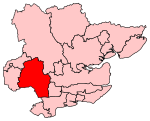Kelvedon Hatch Secret Nuclear Bunker
Buildings and structures in EssexCold War museums in the United KingdomContinuity of governmentEmergency management in the United KingdomGovernment buildings completed in 1953 ... and 4 more
Military and war museums in EnglandMuseums in EssexNuclear bunkers in the United KingdomUse British English from April 2022

The Kelvedon Hatch Secret Nuclear Bunker at Kelvedon Hatch, in the Borough of Brentwood in the English county of Essex, is a large underground bunker maintained during the Cold War as a potential regional government headquarters. Since being decommissioned in 1992, the bunker has been open to the public as a tourist attraction, with a museum focusing on its Cold War history.
Excerpt from the Wikipedia article Kelvedon Hatch Secret Nuclear Bunker (License: CC BY-SA 3.0, Authors, Images).Kelvedon Hatch Secret Nuclear Bunker
Kelvedon Hall Lane, Essex
Geographical coordinates (GPS) Address Nearby Places Show on map
Geographical coordinates (GPS)
| Latitude | Longitude |
|---|---|
| N 51.671805555556 ° | E 0.25655555555556 ° |
Address
Cellular Tower (Orange)
Kelvedon Hall Lane
CM14 5TL Essex, Kelvedon Hatch
England, United Kingdom
Open on Google Maps







